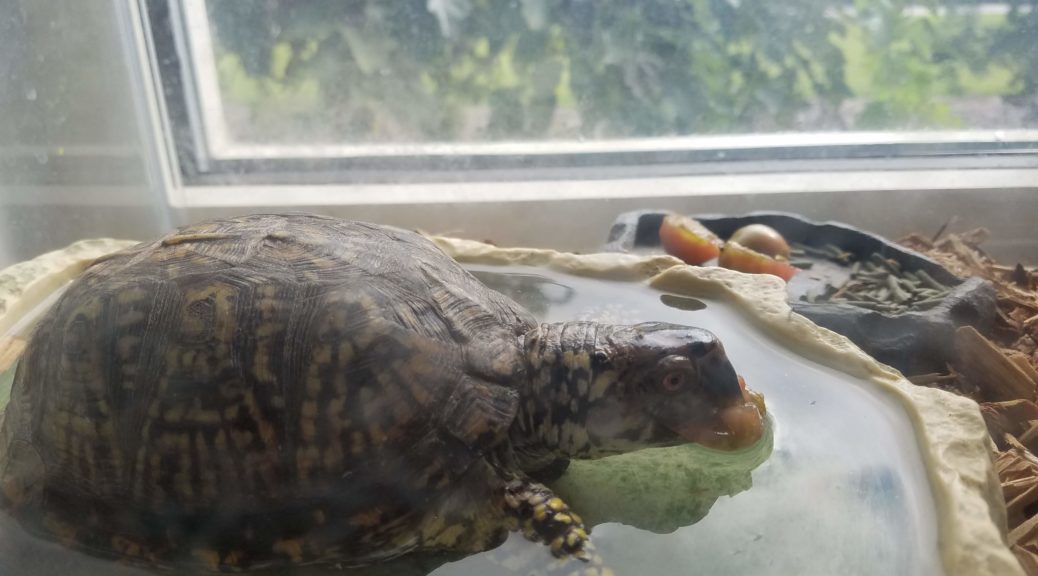I wrote about some happy pet news last week—a tribute to Amos’ eighth year with me. Now, I have some sad pet news to report.
Rocky, my Eastern Box Turtle for the past 15 years or so, has disappeared.
Origins
I adopted Rocky from some Kent State faculty, whose son seem to become bored with him, circa 2007. At the time, I had three other turtles, two Red-eared Sliders and an Eastern Painted Turtle, so Rocky was a treat—a terrestrial turtle who didn’t require a massive water change regularly. I was told that Rocky was wild-caught by a child in school, who brought him into school to hand him over to another graduate student, who was working there at the time, enrolled at Kent State with me. She, Tracy, may have kept Rocky for a few years, then donated him to the other faculty… who had him for a few years. Suffice it to say: it’s hard to know how old he was, but 15 was the bare minimum.
[Edit: According to Tracy: “when I started teaching middle school (97-98) in Columbus, a student had Rocky at home and brought him in as a class pet. Around 2002, Rocky went to live with the Leffs.”
Rocky as a pet
Rocky was a peculiar pet. He slept in weird positions, looking dead, using “pillows”, stretching in odd angles. He would mount anything that vaguely resembled another turtle—from rocks to other species, like a Diamond-backed Terrapin or any one of my other aquatic turtles during a tank cleaning.

Rocky travelled from Ohio to Atlanta and Savannah with me. He first lived in a ~55 gallon terrarium with a water partition, but I moved him to another, smaller tank after I inherited two corn snakes (1 and 2).

In my apartment in Southside in Savannah, Rocky lived on my covered porch for about three years. He over wintered under some potting soil and was greeted each morning by Amos and Eva—when I asked “where’s Rocky?,” Amos would sniff around the porch until he found Rocky and received a treat (I wish to generalize the behavior to use Amos to find turtles in the field… never happed through).

Rocky on my porch, carrying a strawberry around for some reason.
After moving out of Southside, Rocky lived in a closet for a few months (within a terrarium), then, mostly, in my office on campus. I would bring him into some classes when I thought I could relate course content to him (mostly just taxonomy). Rocky would eat tomatoes, poop out the seeds in his water dish, and I would use the turtle water to fertilize some potted plants. The tomato seedlings are still thriving.



Rocky played a weird role in a story I wrote to Nicole when we first met.
During the summers, my friend and colleague, Michele, cared for Rocky while I was in Costa Rica. She treated him well—regular fresh foods and an offer to grind his beak down. Michele had done some freeze-tolerance research on box turtles in undergrad at our alma mater, Nazareth College.
Most recently, during the beginning of the COVID-19 stay-at-home orders, I brought him home and constructed an outdoor enclosure modeled after an enclosure at Skidaway Island State Park. Amos probably enjoyed the enclosure as much as Rocky; Rocky seem to like the additional sun and Amos like to steal Rocky’s uneaten food and water.
Where did he go?
The outdoor enclosure could have resulted in Rocky’s disappearance, and I hope that I didn’t negligently doom him with, what I thought, would be a more comfortable enclosure for him (there is biochemical evidence that enclosure substrate and size reduces stress in box turtles). I found a feather from a hawk in the yard recently—possibly a red-tailed hawk—and there is a Mississippi Kite that may have a next in the pine right above the enclosure. I haven’t read any accounts of predation of adult box turtles by hawks and the kites are relatively small, but I’ve heard some stories from the leader of TERPS, a project that rears terrapins at the Armstrong Campus, about birds of prey stealing smaller turtles. Predation is an awful and gruesome way to go for a turtle; most birds of prey wouldn’t be able to break the shell or otherwise kill the turtle quickly. There’s a slight chance he escaped and is still running around in my backyard. Maybe I’ll find him in the coming months sleeping under a bush. In any case, I enjoyed his company and hope that his captivity and disappearance weren’t stressful or violent.
Some Box Turtle Facts
Some interesting facts about eastern box turtles, all derived from Ernst and Lovich, Turtles of the United States and Canada, 2nd ed., 2009:
- They can develop fevers in response to bacterial infections (fight the SARS-CoV-2)!
- Its northern distribution, including Ontario, may have been facilitated by transport by Native American trade.
- Hibernacula (burrows the turtles dig during winter to hibernate) are relatively shallow (max = 14 cm, average = 4 cm). Rocky used to hibernate under a bag of potting soil in my patio.
- They’re freeze tolerant. Greater than 50% of their body water can freeze without injury with the help of increased glucose and cryoprotectant concentrations.
- Home ranges vary widely, but estimates suggest about 5 hectares (12 acres or 9 football fields of forested habitat) per individual.
- Males have been reported to die on their backs after rolling during mating or fighting for a mate. Rocky’s long neck regularly whipped around to efficiently roll him upright.
- Reports of wild individuals are as high at 138 years old, and individuals some populations may live between 50-80 years, but other estimates put the range lower at 25-35 years.
- Predators of adults are few, but juveniles are eaten by many different animals, from snakes to birds (like the Mississippi Kite and Bald Eagle).







